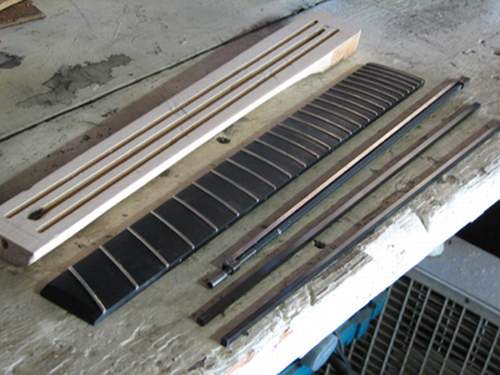Eric Olds Klein Guitar Project – Part 1
Classic guitar designs are often the jumping off points for guitar builds and the Klein electric guitar is no exception. As a classic in its own right, we’ve seen the basic shape used as a starting point several times before including builds by Mats Erikson, PJ Doland as well as my own first project guitar. In every case, each of these has come to life with its own twists and turns over the original.
Enter Eric Olds who shares his version of a Klein based electric guitar. His project includes a fanned fret neck, a home made headpiece and a very well documented headless tuning system of his own design.
These conceptual images show front and back views of the instrument:


Laying out the Guitar
Eric started by importing a JPEG of a Klein guitar into the 3D cad program Solid Works. He then generated several plan drawings to include the guitar body, the fanned fret fingerboard, the neck’s construction and his tuning tail piece. This extra effort is another guitar builder’s gain because Eric has generously made these available to Building the Ergonomic Guitar readers.
And so, here is the first of the plans in Adobe Acrobat format (PDF) – a two page overview of the instrument which includes estimated build costs. Right click on the link below and choose to save:
Klein Guitar Copy Overview.pdf – 583 KB
Fanned Fret Neck
The maple neck has a single truss rod with graphite rod reinforcements on either side making for a good stiff neck:

Eric had this to say about his experience with fanned frets:
So far, fanned frets are pretty easy to play – most of the time you don’t really notice a difference. Some of the low bar chords you have to be a bit more careful with though. (F major, B…) I didn’t go too extreme, the scale length is 25.75 on the low E and 24.25 on the high. (This allowed me to use an existing bridge.) I’m not convinced that they are more comfortable to play (yet…) but they are certainly not any hindrance. With the more even string tension, I’m using heavier strings than I usually do (.013 vs .011) and I’m finding them as easy to play as the lighter strings on my other guitars.
Coming Up
In the next installment, we’ll see shots of the completed guitar, cover Eric’s tuning system and provide two more plans for download:
- Detailed plans of the tuning tailpiece
- A full scale plan of his Klein based guitar body
Stay tuned.
Wow, excellent. Thanks for sharing this design, and I’m certainly looking forward to the next installments!
Marc
wow, ived been dreaming to make one ,this is a good start thanks
ill keep in touch once ive done one.
manny talavera
I’m looking forward to progress reports, Manny.
I know this must sound crazy , but wouldn’t it be more comfortable with the “fan ” towards the bridge…as the frets would then follow the natural arch of your fretting arm…? so normal at the nut for those F chords.
That’s not too crazy- it would be more comfortable at the low end of the neck if the frets fanned the other way- the issue is that you get the most benefit from playing with the scale lengths by allowing the lower, thicker strings to use longer scales- and that dictates the fan. A reasonable compromise might be to keep the lower frets almost straight and fan them more going up the neck- but you’d really need to slant the bridge. (Or use individual saddles) I limited myself to only easy to get parts for this design, so I did a more ‘traditional’ fan…..
Eric
Great job!!! very nice guitar!!!!